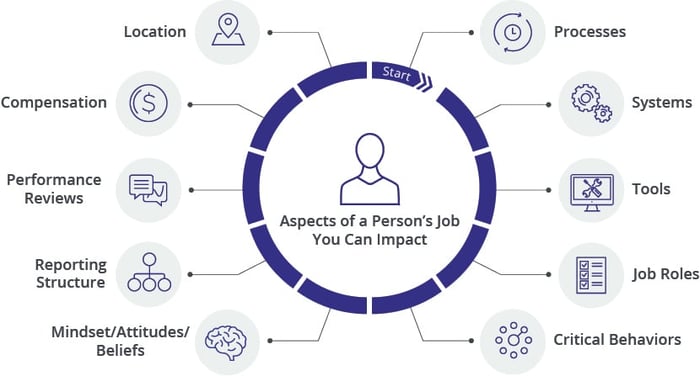8 Alignment Hacks That Enhance Change Management Today

3 Mins
Updated: August 8, 2024
Published: February 24, 2021

Since 2019, the way organizations work has shifted to faster, more iterative approaches that enable rapid changes during uncertain times. While formal approaches are a must for complex transformations, sometimes simple adjustments to those approaches make a world of difference.
The alignment hacks below are simple yet focused. They often help me, our team, and the folks we work with move past roadblocks when the “standard” ways of doing things need adjustments.
Change Management Alignment Hacks
1. Pivot around purpose
This hack is so relevant to our current situation, it bears repeating and remembering. In the face of chaos, we can chaotically flail or pivot. But to pivot effectively, we need a fulcrum to pivot around. That fulcrum is purpose. It's being anchored in who we are as an individual, as a team, as an organization, as an initiative. If we can anchor to purpose, that's when we can pivot, even with constantly shifting conditions.
2. To what end?
My team hears this phrase probably more than any other. What are we trying to achieve? What is the goal? What is the outcome? What are we trying to get out of the effort we are putting in? And if we are unclear on “to what end,” or if my answer to “to what end” differs from yours, even a little, the amount of wasted energy and effort can be significant. Aligning on a shared definition of success is critically important.
3. Name it to tame it
If we want to unlock a challenge, seize an opportunity, or amplify an asset, we must truly understand what that challenge, opportunity or asset is. That degree of clarity we bring to the conversation helps us name the changes and help people move forward. The 10 Aspects of Change Impact model lays out very clearly the ways a change affects impacted groups in their daily work. Leveraging this model along with focused tools helps you collectively define and assess change impact and leverage the insights for success.

Prosci's 10 Aspects of Change Impact

4. Matching matters
How do we match the right amount of effort to effect a response to a situation, the solution to the opportunity, or the problem to the solution? Too often we bring a simple solution to a problem that needed a complex solution, or we bring a complex solution to a problem that really only needed a simple solution. Matching is the key—right sizing the effort and then making sure that we are matching the right approach to it. Right now, nobody has extra time and energy to be running around, bringing the wrong solution to the table. We run a real risk of developing Rube Goldberg innovations, over-engineering a solution, if we aren't focused on matching.
5. Solution laps
We introduced this approach at Prosci to prioritize our pandemic response efforts. Very quickly, we identified what we called lap 1 solutions to address what was right in front of us. Lap 2 solutions helped us improve on what we put into place once conditions stabilized, and lap 3 solutions continue to help us reinvent ourselves—those strategic transformations that enable us to become who we want to become. For example, we had an idea to offer weekend Change Management Certification Programs because people were juggling crazy schedules. But we didn't even have a virtual program in place to stabilize. So, we put the idea into lap 2. Once implemented, those weekend programs quickly became popular and still are. Because we parked the idea in lap 2, we were able to bring it to life successfully at the right time.
 Prosci's Virtual, Instructor-Led Change Management Certification Program
Prosci's Virtual, Instructor-Led Change Management Certification Program
6. Words make worlds
Some say change management is an oxymoron—change can't be managed because it’s organic. That's a bit of a copout to me. But there are certainly better and worse ways to tee up information for individuals when answering their questions as they experience a change. Words make worlds, so being thoughtful about the language we use in this discipline is important. Some alternatives to the term “change management” include change facilitation, adoption enablement, change enablement, and my personal favorite, benefit realization insurance. What you choose to call it depends on your unique organization and its people.
7. Top of mind, not top priority
The nature and pace of change today makes alignment across teams essential. When the timing of a message I sent to a team member was interpreted as urgent, the misalignment made me realize I needed a way to signal that, “just because this is what I’m thinking about right now doesn’t mean you need to re-prioritize your work.” Now I use “Top of mind, not top priority” to lead off emails. This promotes alignment and shared priorities while reducing unintended consequences.
8. Progress over perfection
As a perfectionist, this one is really hard for me to swallow. But in today's world, there's a huge opportunity to get stuck if we let ourselves become obsessed with perfection. Instead, we must embrace the opportunity to get better than we would have been, to do better than we had to, to do better than we might have if we didn't get thoughtful about the people side of change. Embrace and grab on to those opportunities for progress. Perfection is the enemy when conditions are changing rapidly.
Aligning Change Management to Your Organization
The hacks above are fast and easy to implement. They’re not the entire change management picture, of course, far from it. But when you apply a structured process and set of tools to lead people through change, these alignment hacks can help you quickly adjust your approaches as needed. After all, effective change management is about putting people at the center of the change and meeting them where they are.


